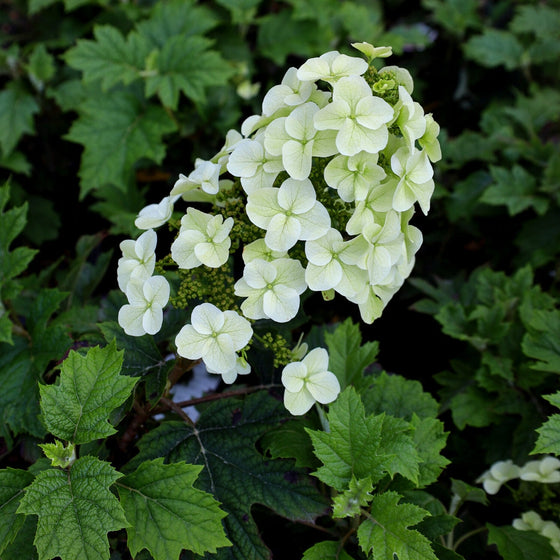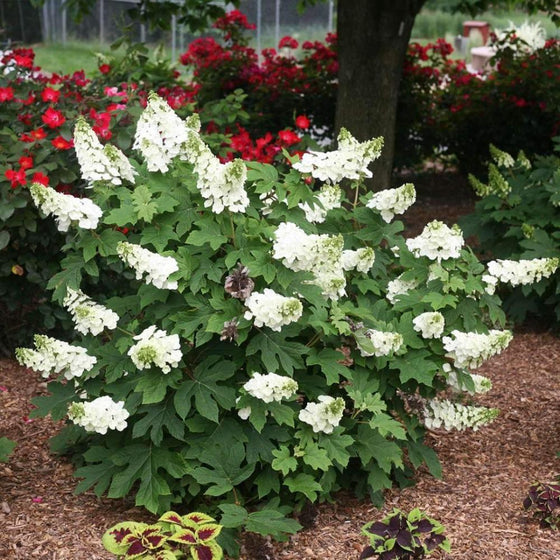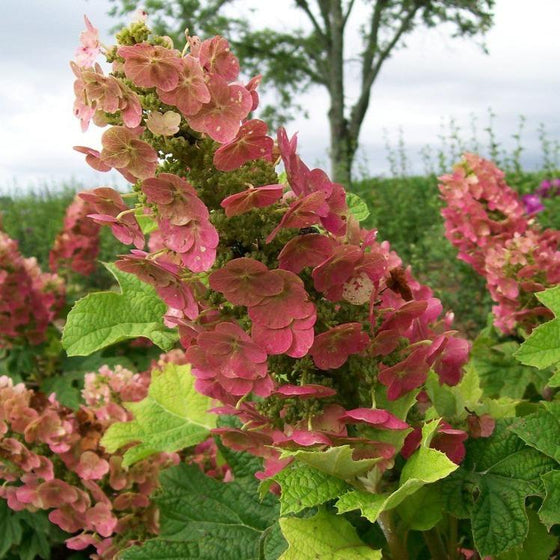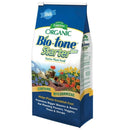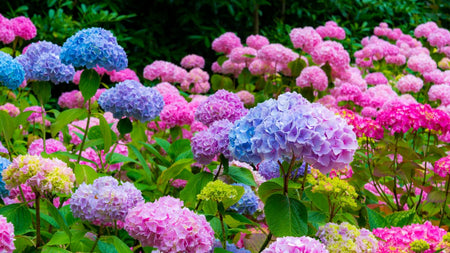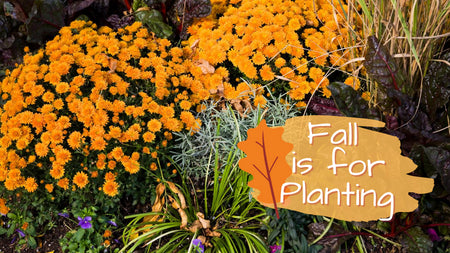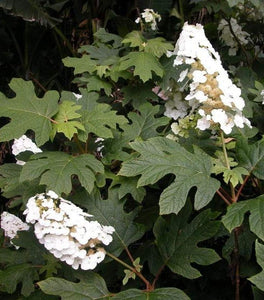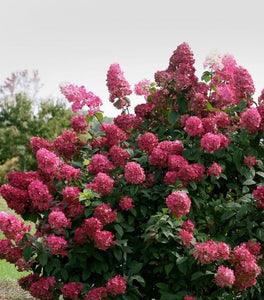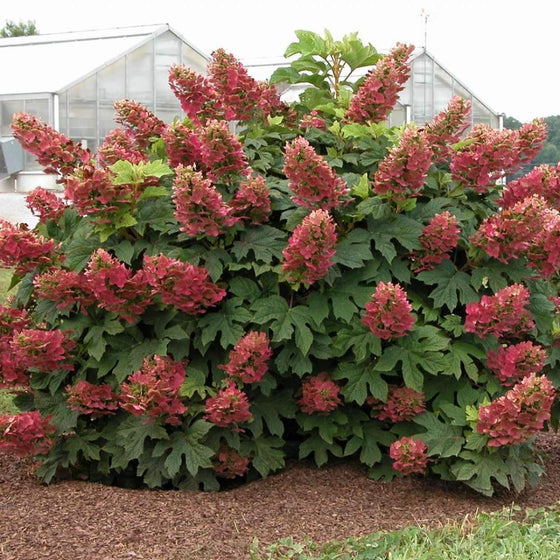
Images Depict Mature Plants
Ruby Slippers Oakleaf Hydrangea for Sale
The Ruby Slippers Hydrangea, known scientifically as Hydrangea quercifolia 'Ruby Slippers,' is a stunning cultivar of our native Oakleaf Hydrangea that offers a spectacular display of color and beauty in any garden. This compact shrub typically grows to about 3 to 4 feet in height and up to 5 feet in width, making it a popular choice for small and large landscapes. The most notable characteristics of the Ruby Slippers Hydrangea are its large, oak leaf-shaped leaves and the sizeable conical flower clusters that transition from white to a rich ruby red as the season progresses. This hydrangea variety thrives in USDA Hardiness Zones 5 through 9, making it a versatile choice for many gardeners seeking a reliable, eye-catching flowering shrub.
Cultivating the Ruby Slippers Hydrangea is rewarding as it is relatively low maintenance yet yields a high visual return. It prefers well-drained soil with moderate moisture and can thrive in both full sun and partial shade, although too much direct sunlight can lead to scorched leaves. This native hydrangea is particularly noted for its ability to adapt to different soil pH levels, which influences the color intensity of its blooms. Ruby Slippers Hydrangea is also resistant to pests and diseases, making it a care-free choice for beginner and experienced gardeners. Its fall foliage is also spectacular, with leaves turning from green to a rich mahogany red, providing extended seasonal interest well into the winter.
The Ruby Slippers Hydrangea is an excellent selection for gardeners looking to add color and elegance to their outdoor spaces. It works beautifully in mixed borders, as a foundation planting, or even in mass plantings for a more dramatic effect. During the summer, the flowers bloom in profusion, creating a vivid display that attracts pollinators such as butterflies and honey bees. The Ruby Slippers Hydrangea also makes excellent cut flowers, adding a touch of natural beauty to any indoor setting. Overall, this hydrangea cultivar is a delightful addition to any garden, offering multi-season appeal and requiring minimal care for maximum enjoyment.
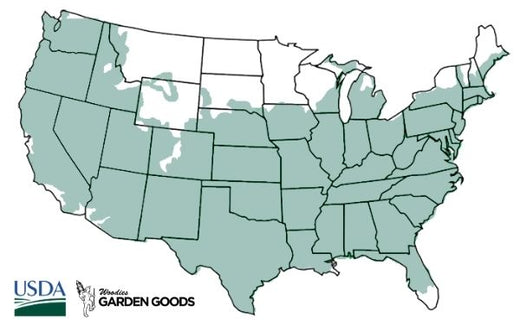
| Hardiness Zone: | 5-9 |
|---|---|
| Mature Width: | 4 to 5 Feet |
| Mature Height: | 3 to 4 Feet |
| Classification: | Broad leaved deciduous shrub, mid-summer flowering |
| Sunlight: | Part sun to part shade |
| Habit: | Upright, densely branched |
| Flower Color: | White flowers in summer turn red in fall |
| Foliage: | Dark green turning reddish mahogany in the fall |
| Soil Condition: | Any well drained soil |
| Water Requirement: | Water well until established |
| Uses: | Extremely attractive when used as a focal point in the woodland border, mass planting, specimen planting, or container planting |
How to Care for Ruby Slippers Hydrangea
Be sure to read our planting instructions to ensure a healthy and happy Ruby Slippers Hydrangea plant for years to come!
How do I plant my Ruby Slippers Oak Leaf Hydrangea?
Planting a Ruby Slippers Hydrangea starts with selecting a site with well-draining soil and full sun to partial shade. This hydrangea thrives in USDA zones 5 through 9 and prefers moist, fertile soil with a neutral to acidic pH. When planting, dig a hole as deep as the root ball and twice as wide, mixing in organic compost to enrich the soil and promote healthy growth. Ensure adequate spacing, about 3 to 5 feet apart, to allow for air circulation and full expansion as the plant matures. Regular watering, especially during dry spells, and mulching will help retain soil moisture and maintain even soil temperatures, fostering a lush, vibrant display of flowers every summer.
How and when should I water my Ruby Slippers Hydrangea?
Watering a Ruby Slippers Hydrangea is crucial to its growth and bloom success, especially during its establishment period and in hotter climates. This hydrangea variety benefits from regular, deep watering to keep the soil consistently moist but not soggy. The best time to water is early in the morning, which helps prevent evaporation and reduces the risk of fungal diseases by allowing the leaves to dry before nightfall. During the hot summer months, increase watering frequency to counteract the drying effects of the heat, particularly if the hydrangea is planted in areas with full sun. In cooler weather or rainy seasons, reduce watering to match the plant's lower hydration needs. Always adjust your watering schedule based on rainfall, soil type, and current weather conditions to maintain optimal soil moisture and encourage robust growth and flowering. Once established Ruby slippers hydrangea will only need supplemental watering during periods of extreme drought.
What type of fertilizer should I use for my Ruby Slippers Oakleaf Hydrangeas?
Fertilizing a Ruby Slippers Hydrangea is essential to promote vigorous growth and stunning floral displays. This hydrangea benefits from a balanced, slow-release fertilizer that ensures a steady supply of nutrients throughout the growing season. It's advisable to apply a granular fertilizer formulated specifically for flowering shrubs, with an NPK ratio close to 10-10-10, early in the spring as new growth appears. This initial feeding kick-starts the growing season, supporting the development of both foliage and blooms. Additionally, a second application in mid-summer can help sustain the plant's energy needs as it prepares for blooming. Be cautious with the amount of fertilizer used; over-fertilization can lead to lush foliage at the expense of bloom production and may also contribute to increased susceptibility to pests and diseases. The timing of fertilizer application for Ruby Slippers Hydrangea is critical for optimal health and flowering. After the first flush of spring growth, a light application of fertilizer helps the plant establish its extensive bloom cycle. Ensure that the fertilizer is applied to moist soil and thoroughly watered in to prevent root burn and to help distribute the nutrients. Avoid fertilizing late in the growing season as new growth needs time to harden off before the onset of winter. Using an organic compost as a top dressing in the fall can also enhance the soil's fertility and structure, providing a natural boost of nutrients and improving overwintering capabilities. Regular feeding, aligned with the hydrangea's growth cycle and seasonal needs, ensures your Ruby Slippers Hydrangea remains robust and happy throughout the year.
What type of mulch should I use for an Oakleaf Hydrangea?
Mulching is a vital care step for the Ruby Slippers Hydrangea, enhancing soil moisture retention, temperature regulation, and weed suppression around the plant. Organic mulches such as shredded bark, pine needles, or leaf compost are ideal as they gradually break down, enriching the soil with nutrients. The optimal time to apply mulch is in late spring after the soil has warmed up, which helps maintain a cool root environment and conserves water during the hotter months. A second layer of mulch can be added in late fall to protect the roots from freezing temperatures and temperature fluctuations in winter, but this is not necessary. When mulching, ensure to keep the material a few inches away from the plant’s stem to prevent moisture-related diseases and to allow for proper air circulation. A 2 to 3-inch layer of mulch is sufficient to effectively cover the soil and benefit the hydrangea’s health and growth.

